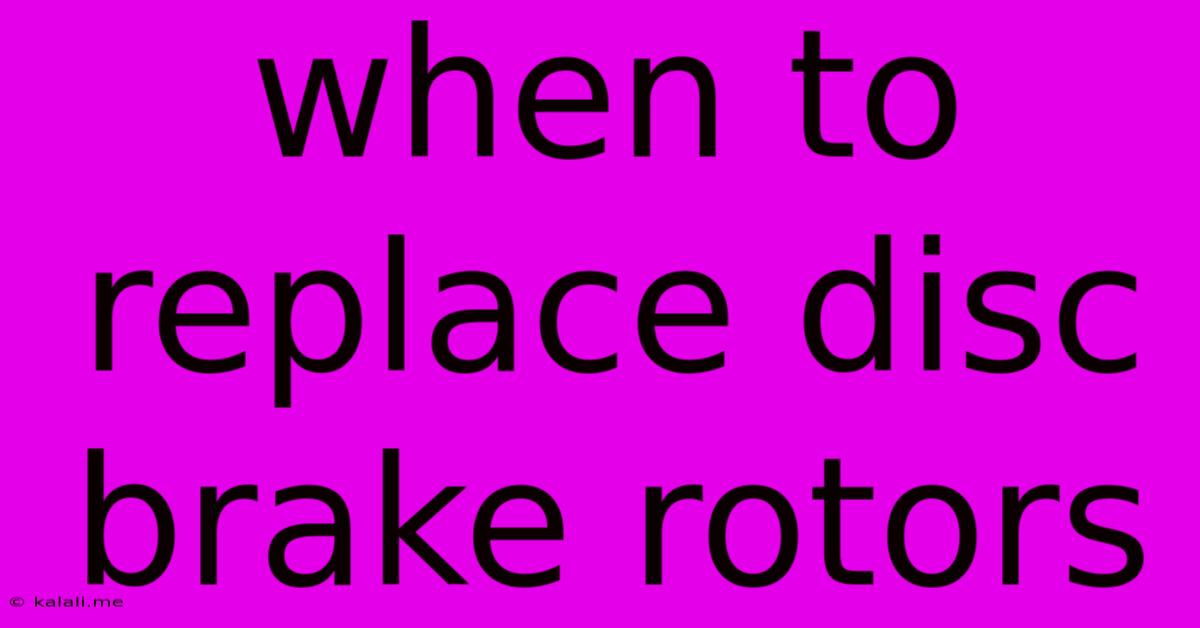When To Replace Disc Brake Rotors
Kalali
May 26, 2025 · 3 min read

Table of Contents
When to Replace Disc Brake Rotors: A Comprehensive Guide
Meta Description: Learn when to replace your disc brake rotors to ensure optimal braking performance and safety. This guide covers visual inspections, measurement techniques, and signs indicating worn-out rotors.
Disc brake rotors are critical components of your vehicle's braking system, responsible for slowing and stopping your car. Ignoring their condition can compromise your safety and lead to expensive repairs down the line. This guide provides a comprehensive overview of when you should consider replacing your disc brake rotors. We'll cover visual inspection, measurement techniques, and the tell-tale signs that your rotors need replacing.
Visual Inspection: The First Step
Before resorting to more technical measurements, a thorough visual inspection is crucial. Look for the following:
-
Excessive Rust: While surface rust is often harmless, significant rust buildup, especially pitting or deep corrosion, reduces braking effectiveness and can lead to uneven braking. Severe rust indicates the rotor is compromised and should be replaced.
-
Grooves and Scoring: Deep grooves or scoring on the rotor surface significantly reduces friction, impacting braking performance. These imperfections can be felt as vibrations through the brake pedal.
-
Cracks or Breaks: Cracks, even small ones, are a serious safety hazard. A cracked rotor can shatter under braking force, leading to catastrophic brake failure. Replacement is mandatory if cracks are detected.
-
Excessive Wear: Thinning of the rotor material beyond manufacturer specifications is a clear indication of wear and tear. This is particularly noticeable at the edges.
-
Glazing: A glazed surface appears shiny and smooth, lacking the necessary texture for optimal brake pad contact. Glazing reduces braking power and increases stopping distance.
Measuring Your Disc Brake Rotors
While visual inspection is essential, using a caliper to measure the rotor thickness provides a more precise assessment. Consult your vehicle's owner's manual to find the minimum thickness specification for your rotors. Typically, the minimum thickness is etched onto the rotor itself.
-
Compare Measurements: Carefully measure the thickness of your rotors at multiple points, comparing them to the manufacturer's minimum thickness. If the rotor is thinner than the specification, it's time for a replacement. Uneven thickness across the rotor also indicates a problem and necessitates replacement.
-
Minimum Thickness Variation: Even if the overall thickness is within the acceptable range, significant variations in thickness across the rotor's surface point to uneven wear, compromising braking performance and potentially leading to brake pulsation (vibrations in the brake pedal).
Signs Your Disc Brake Rotors Need Replacing
Beyond visual inspection and measurements, several driving experiences signal that your disc brake rotors are nearing the end of their life:
-
Brake Pedal Pulsation: A pulsating or vibrating brake pedal during braking indicates uneven wear on your rotors, potentially causing warped rotors. This is a safety concern and warrants immediate attention.
-
Reduced Braking Performance: If you notice a significant decrease in your braking power, your rotors could be the culprit. This could be due to excessive wear, glazing, or severe corrosion.
-
Unusual Noises: Grinding, squealing, or metallic scraping sounds during braking often indicate worn-out rotors or damaged brake pads. Investigate promptly to pinpoint the problem.
-
Brake Warning Light: While this isn't always directly related to rotors, a consistently illuminated brake warning light indicates a problem within the braking system. Have it checked immediately by a professional mechanic.
Conclusion: Prioritize Safety
Replacing your disc brake rotors is crucial for maintaining optimal braking performance and ensuring your safety. Regular inspections, combined with careful measurement and attention to driving indicators, will help you identify when replacement is necessary. Remember, neglecting worn rotors can lead to accidents and costly repairs. When in doubt, consult a qualified mechanic.
Latest Posts
Latest Posts
-
Is Christmas Cactus Plant Poisonous To Cats
May 27, 2025
-
Is Doom Eternal After Doom 2016
May 27, 2025
-
How Long Does It Take For Latex Paint To Dry
May 27, 2025
-
Are Gold Potatoes The Same As Yukon Gold
May 27, 2025
-
Entailment In To Kill A Mockingbird
May 27, 2025
Related Post
Thank you for visiting our website which covers about When To Replace Disc Brake Rotors . We hope the information provided has been useful to you. Feel free to contact us if you have any questions or need further assistance. See you next time and don't miss to bookmark.